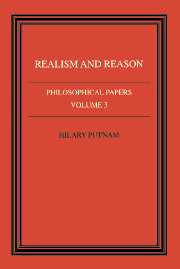Book contents
- Frontmatter
- Contents
- Dedication
- Introduction
- 1 Models and reality
- 2 Equivalence
- 3 Possibility and necessity
- 4 Reference and truth
- 5 ‘Two dogmas’ revisited
- 6 There is at least one a priori truth
- 7 Analyticity and apriority: beyond Wittgenstein and Quine
- 8 Computational psychology and interpretation theory
- 9 Reflections on Goodman's Ways of Worldmaking
- 10 Convention: a theme in philosophy
- 11 Philosophers and human understanding
- 12 Why there isn't a ready-made world
- 13 Why reason can't be naturalized
- 14 Quantum mechanics and the observer
- 15 Vagueness and alternative logic
- 16 Beyond historicism
- Bibliography
- Acknowledgements
- Index
14 - Quantum mechanics and the observer
Published online by Cambridge University Press: 06 January 2010
- Frontmatter
- Contents
- Dedication
- Introduction
- 1 Models and reality
- 2 Equivalence
- 3 Possibility and necessity
- 4 Reference and truth
- 5 ‘Two dogmas’ revisited
- 6 There is at least one a priori truth
- 7 Analyticity and apriority: beyond Wittgenstein and Quine
- 8 Computational psychology and interpretation theory
- 9 Reflections on Goodman's Ways of Worldmaking
- 10 Convention: a theme in philosophy
- 11 Philosophers and human understanding
- 12 Why there isn't a ready-made world
- 13 Why reason can't be naturalized
- 14 Quantum mechanics and the observer
- 15 Vagueness and alternative logic
- 16 Beyond historicism
- Bibliography
- Acknowledgements
- Index
Summary
The thing that strikes everyone who looks at quantum mechanics is ‘superposition of states’. For example, one can have a hydrogen atom in such a condition that the probability that it is at one energy level is 25% and the probability that it is at the next higher energy level is 75%. Now, the problem is that one should not think of this as meaning that the atom is either at the first energy level or the second but we don't know which. What then does it mean? That is the question! That is what ‘interpretations’ of quantum mechanics are all about.
I shall not review the argument to show that one cannot think of it in a classical way, that one cannot think of it as meaning that the energy level is one or the other (nor can one think of it as meaning that the hydrogen atom is at an in-between energy level). Physicists gave up that way of viewing it (which is, unfortunately, the only way of viewing it that one can ‘explain to a barmaid’, in Rutherford's phrase) long before there were more-or-less formal proofs that one cannot view it that way.
Formal proofs that there are no hidden variables are not, I think, what has played a role in the thinking of physicists; what physicists are more impressed by is the fact that if one tries to think of it that way then it doesn't square with any intelligible physical picture at all.
- Type
- Chapter
- Information
- Philosophical Papers , pp. 248 - 270Publisher: Cambridge University PressPrint publication year: 1983
- 2
- Cited by



